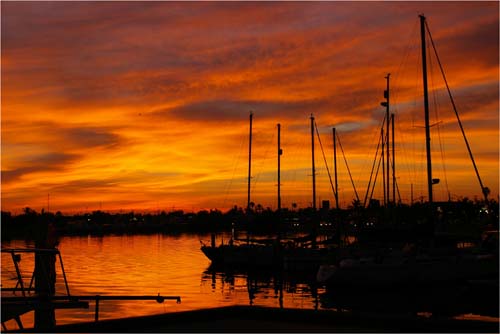Just as we are set to weigh anchor, I discover I have the
wrong A/C adapter for my computer.
No adapter, no computer.
No computer, no charts. That
is, no electronic charts, which means I have to rely on paper chartsówhich
got me here from Seattle 10 years ago.
But who wants to do hand navigation and calculations any more?

Sunset at Garrison Bight
We motor around Fleming Key to Garrison Bight and, with
the help of neighbor Rosemary, tie up in my old slip across the pier from
the houseboat, retrieve the proper adapter, make a couple of phone calls,
and we are off again.
From Sand Key, I set a course somewhat diagonally across
the NE flow of the Gulf Stream, hoping to
get the worst over first. The
plan is to get close enough to
Cuba
to take advantage of the west flowing counter current.
It is not a bad crossing, as there is little or no wind to stir up
the Gulf Stream.
The downside of this:
With no wind to counteract, the Stream pushes us considerably off course, to
the east whereas Mexico is to the west.
By midday
the following day we are off the coast of
Havana,
Cuba.
There is a US Coast Guard Cutter lying here, about 12 miles off
Cubaís coast, ostensibly to remind us that to go closer will put us in the
territorial waters of Cuba. At
which time the Coast Guard would/could board the
Sirius II to discover our
intentions. Going to Cuba means spending money there
which is against US
policy: Trading with the enemy!
To avoid this, and a possible confiscation of the vessel and/or
electronics, I set a new course to keep the boat 12 miles off
Cubaís
coast.
The results of this decision are immediate.
We are still in the broad area of the northeast flow of the
Gulf Stream, not close enough to Cuba to get the
counter current I want. Bucking the
current, with no wind, our forward progress falls to three knots and less,
as opposed to the five knots I had planned.
By Monday afternoon, after more than 48 hours of motoring
(our first night out we were able to sail for about five hours), I have to
admit that we have a problem.
At this rate, there will not be enough fuel to make it to Mexico.
I pour the 10 gallons of
diesel from the jerry cans into the main tank and start looking for a port
in Cuba to refuel, even though contrary to Americaís convoluted policy.
Even the US Coast Guard canít fault a sailor who puts into port for
necessary provisions. Can they?
Nigel Calderís Cuba:
A Cruising Guide reports that the industrial town of Santa Lucia, about five
hours away (thus, five gallons of diesel under these conditions) is a port
of entry and surely we can take on fuel there.
Arriving just before night fall, we tie up at the Guarda dock and are
told we canít leave the vessel and must wait until tomorrow morning to do
business. That is when we find
out that Santa Lucia is no longer a port of entry and we canít do business
with them without proper clearance.
And we canít get proper clearance here.
My plea about lack of fuel doesnít faze the Guarda.
We are directed to the new port of entry close to the
western tip of Cuba,
Punta Morros, about 80 nautical miles distance.
Do I have enough fuel?
Fortunately, motoring much closer to Cuba we are now out of the Gulf Stream and are able to maintain a speed of five
knots.
Arriving just at dark, again we are told to wait until
tomorrow to do business. Then,
as is the common practice in
Cuba, we are boarded by officials from
emigration, customs, agriculture, health and security all at the same time,
some asking the same questions.
Before we can buy fuel, we have to officially check in to
Cuba
(and check out). With the 23%
discount Cuba now imposes
on the US dollar (i.e., each $100 is only worth $77), this is by far the
most expensive fuel I have ever purchased.
To be sure, I donít get any more fuel than I think I will need to
cross the Yucatan Channel to
Mexico!
